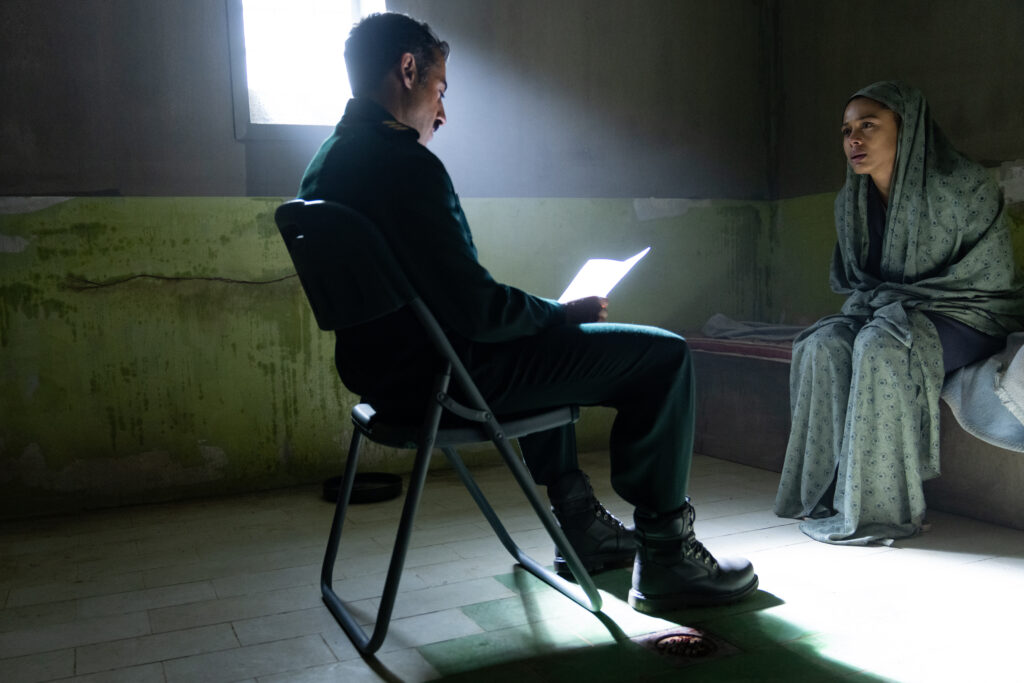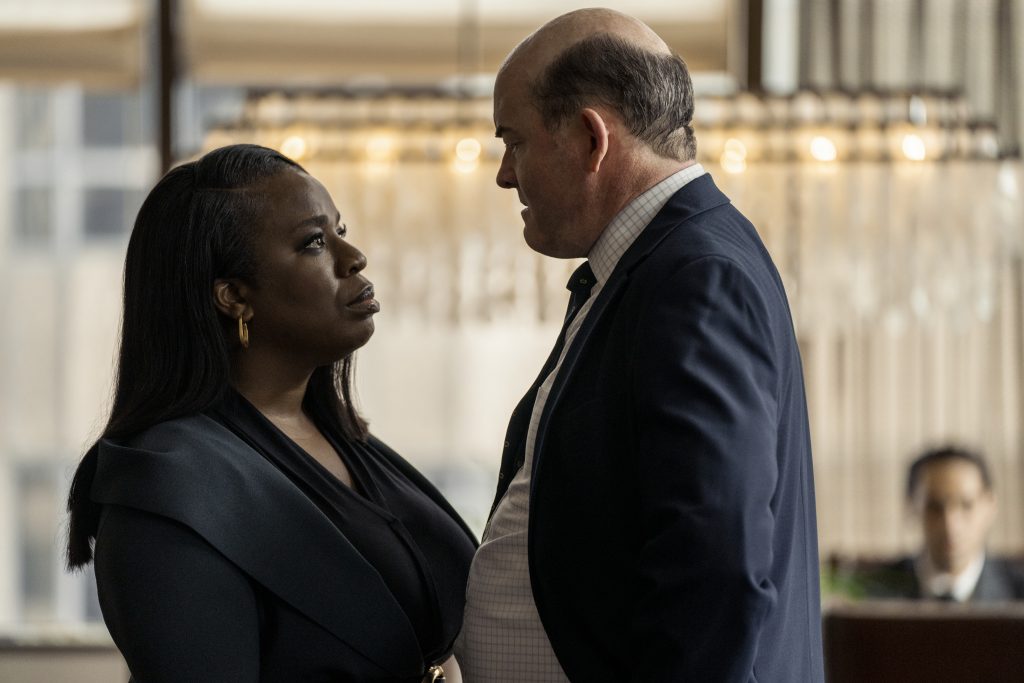May 28, 2023
by Carla Hay

Directed by Ric Roman Waugh
Some language in Persian, Arabic and Urdu with subtitles
Culture Representation: Taking place in the mid-2010s in Iran, Dubai, Pakistan, Afghanistan, the United States, and the United Kingdom, the action film “Kandahar” features a white and Middle Eastern cast of characters representing the working-class and middle-class.
Culture Clash: A Scottish military-trained operative, on loan from MI6, works undercover with the CIA to stop terrorism in the Middle East, but his cover is blown, and he and an interpreter must find their way to safety at an extraction point in Kandahar, Afghanistan.
Culture Audience: “Kandahar” will primarily appeal to people who are fans of star Gerard Butler and formulaic and forgettable action movies about fighting terrorists in the Middle East.

“Kandahar” gets awfully convoluted and takes too long to get to the main mission in the story. The film editing is sloppy, while the action scenes are unremarkable. The movie’s worst idea is the secret CIA surveillance room that gets unrealistic footage. It’s yet another violent action flick about stopping terrorists in the Middle East, with a predictable protagonist who’s “rough around the edges” heroic. The problem is that “Kandahar” gets so distracted with subplots, the movie just ends up being a formulaic mush of chase scenes, explosions and fights in Middle Eastern locations.
Directed by Ric Roman Waugh and written by Mitchell LaFortune, “Kandahar” seems very impressed with itself in showing all the international locations where the story is supposed to take place, but there’s very little character development in all of this nation-hopping. The movie, which takes place in the mid-2010s, jumps back and forth to scenes that are supposed to take place in Iran, Dubai, Pakistan, Afghanistan, the United States, and the United Kingdom. “Kandahar” was actually filmed in Saudi Arabia.
The first 30 minutes of the two-hour “Kandahar” is like watching a racing car spin its wheels and not getting anywhere. A lot of viewers who watch “Kandahar” without knowing anything about it in advance will be wondering during these first 30 minutes exactly what this movie is going to be about. The movie’s first 30 minutes are a very long setup to show that Tom Harris (played by Gerard Butler), a gruff and tough undercover operative originally from Scotland, is on loan from MI6 to the CIA. He’s embedded as part of a CIA mission to destroy Iran’s nuclear program before Iran has a chance to build a catastrophic bomb.
The opening scene shows Tom and a CIA operative named Oliver Altman (played by Tom Rhys Harries) getting detained by Iranian soldiers in a desert in Qom, Iran. Tom and Oliver are posing as service employees for a company named SIBLIXT Communications, and they have a SIBLIXT Communications van as part of their cover. When Oliver and Tom are questioned by the suspicious soldiers, Tom (who is seen as the bigger threat) and Oliver insist that they were hired by the Iranian government to work on telephone lines so that the city of Qom can have better Internet connectivity.
It all looks so phony, because this setting is in a remote desert area, with no telephone lines in sight. Tom and Oliver being obvious Westerners are also big indications that they’re not who they say they are. They might as well be wearing T-shirts that say “Undercover Operatives From a Western Nation.” Tom shows the interior of the van to the soldiers, in order to prove that Tom and Oliver have no weapons. Tom also shows them some video footage on his cell phone to “prove” that there’s Internet service in the area.
Even though none of this proves that Tom and Oliver are who they say they, the soldiers let Tom and Oliver go anyway. Oliver and Tom drive away with some relief and pride that the soldiers believed their story. The only purpose of this scene is to show viewers that Tom has the skills to talk his way out of tricky situations with dimwitted soldiers.
Meanwhile, a British journalist named Luna Cujai (played by Nina Toussaint-White) is seen getting some photos emailed to her from a U.S. Pentagon contact named James. These photos are irrefutable evidence that the CIA is involved in covert operations that are usually not sanctioned by the government (also known as black ops), and this activity is happening in Iran and other parts of the Middle East. Luna has a phone conversation with a supervisor to tell this boss that she has uncovered some bombshell information.
“It’s a bigger scandal than [Edward] Snowden and WikiLeaks combined,” Luna excitedly tells her supervisor. She then sends the incriminating evidence to her boss, who is never seen on camera. And when a journalist in a movie about fighting terrorism uncovers something that could be an international scandal, it’s easy to predict that the journalist is going to be in some peril at some point in the movie. As already shown in the trailer for “Kandahar,” Luna gets kidnapped.
Tom’s main CIA contact in the Middle East is another undercover operative named Roman Chalmers (played by Travis Fimmel), an American who is mostly seen having secretive phone conversations while dressed in traditional Middle Eastern garb. Roman’s big action scenes don’t come until much later in the movie. What looks very fake about many of Roman’s phone conversation scenes is that he discusses classified information while walking around in public, as if no one else can eavesdrop on these public conversations.
And it wouldn’t be a typical Gerard Butler action movie without part of the plot being about his “hero” character having a race against time to get home safely to a family member. In the case of Tom, he has promised his soon-to-be ex-wife Corrine Harris (played by Rebecca Calder) that he will be back in the United Kingdom in time go to the high-school graduation ceremony of their daughter Ida Harris (played by Olivia-Mai Barrett), who wants to become a doctor.
During a phone conversation between Tom and Corrine, she says that she wants Tom to sign their divorce papers. Corrine tells him that she has a new man in her life but doesn’t go into further details. Corrine suggests that, for Ida’s sake, Tom should find a safer line of work, such as teaching. Tom replies, “I’m not really interested in sitting behind a desk all day.”
Meanwhile, Roman has hired an Iranian interpreter named Mohammad “Mo” Doud (played by Navid Negahban) to work with Tom for their undercover mission. Mo needs the money, but he has another motivation to do this potentially dangerous job. Mo eventually tells Tom that Mo blames the Taliban for the death of his son Amin, who was Mo’s only child. In a movie like “Kandahar,” the odds are very high that Mo will come face-to-face with the man who murdered Amin.
Mo is also looking for the missing sister of his wife Adila Doud (played by Reem AlHabib), who is a typical “worried wife at home” character that’s very common in macho movies like “Kandahar,” where only men are seen in combat. Mo’s search for his missing sister-in-law is yet another subplot that gets thrown into the movie, only to be mishandled and lost in the overall muddled story. Expect to hear Tom give multiple apologies to Mo for various screw-ups and deliberate miscommunications that are in the movie just to create more drama.
“Kandahar” has generic depictions of the CIA and Tom’s opponents. A meeting between the Taliban Shura leadership with Pakistani Inter-Services Intelligence (I.S.I.) at I.S.I. headquarters in Islamabad, Pakistan, is plunked into the movie like a soulless and drab corporate meeting, with characters who are mostly nameless. The movie makes little effort to have memorable antagonists to the “heroes.”
There’s a cold-blooded Iranian government operative leader named Bashar Hamadani (played by Vassilis Koukalani), a Taliban ally, who orders the kidnapping of Luna, when he finds out that she has valuable information about CIA operations in Iran and elsewhere. Farzad Asadi (played by Bahador Foladi), who is Bashar’s loyal subordinate, is the main person who interrogates Luna when she’s in captivity. A ruthless assassin named Kahil (played by Ali Fazal) is supposed to be a rising star in the Taliban, but he comes and goes in the movie with all the personality of a cardboard cutout.
And the CIA officers giving orders and making leadership decisions are equally lacking in distinctive personalities. Mark Lowe (played by Mark Arnold) and Chris Hoyt (played by Corey Johnson) are the bland CIA officials who are given the most screen time. Mark and Chris do a lot of monitoring in a secret CIA room with giant video screens. This secret room has inexplicably perfect aerial views of whatever fight scenes or chases are going with the CIA operatives on the ground, even though there are no drones in the sky during these scenes to explain how the CIA is getting this video footage.
The secret CIA room can also pick up audio with pristine sound levels when people are giving chase or are being chased in the same scene. In other words, the CIA can listen in on what’s being said during these chase scenes. Who knew that the CIA could somehow plant invisible microphones on the Taliban in the middle of a chase scene that’s usually in a remote desert? And it’s all filmed for the CIA from the air and sometimes in the vehicles that are involved in the chase.
Because yes, “Kandahar” wants viewers to believe that the CIA has all this magical surveillance equipment to monitor CIA operatives and opponents, but the CIA can’t figure out how to get Tom and Mo to safety when Tom’s cover is blown because the information that journalist Luna uncovered is leaked to the Taliban. Tom and Mo’s only hope for safety is to reach an extraction point in Kandahar, Afghanistan, but there comes a point in the movie when Tom and Mo are left to figure out how to get there on their own. Somehow, the CIA’s magical surveillance room isn’t going to work to find Tom and Mo, because there would be no “Kandahar” movie if Tom and Mo weren’t left stranded in the desert with Taliban soldiers chasing after them, which is the movie’s main dramatic hook.
The acting performances in “Kandahar” aren’t terrible, but they’re not great either. That’s because almost everyone in the movie is written like a video game character. Negahban’s performance as Mo is the exception, since there’s real depth to his portrayal of the Mo character, who has more at stake in trying to stay alive than making it on time to a child’s graduation ceremony. Hollywood movies almost never have characters like Mo as the central protagonists. The type of suffering that Mo lives with is just too real for make-believe films that want to perpetuate myths about a certain stereotypical character who is almost always the main hero of the story.
Open Road Films and Briarcliff Entertainment released “Kandahar” on U.S. cinemas on May 26, 2023.




